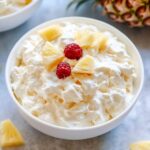Okonomiyaki is a beloved Japanese savory pancake that translates to “grilled as you like it.” This versatile dish allows for a variety of ingredients, making it a customizable favorite in Japanese cuisine. Typically enjoyed as a street food or a homemade meal, okonomiyaki combines a flavorful batter with fillings like cabbage, proteins, and other vegetables, all cooked to perfection and topped with distinctive sauces and condiments.
Full Recipe:
Ingredients
-
For the Batter:
- ⅔ cup plain flour (all-purpose flour)
- 2 tablespoons cornstarch
- ½ cup warm water
- 1 teaspoon dashi powder dissolved in the warm water (substitute with chicken or vegetable stock if preferred)
- 3 eggs
- ¼ cabbage (approximately 300 g / 10.5 oz), finely shredded
- 1–2 spring onions (green onions), sliced (reserve half for garnish)
- ½ cup corn kernels (tinned or fresh)
- 2 tablespoons vegetable oil (for cooking)
-
For the Filling:
- 4 bacon slices, sliced, fat and rind removed (can substitute with pork belly or other proteins like shrimp or chicken)
-
Toppings:
- 2 tablespoons Kewpie mayonnaise
- 2 tablespoons okonomiyaki sauce
- 1 teaspoon seaweed flakes (aonori)
- 1 teaspoon bonito flakes (katsuobushi)
- Directions
-
Prepare the Bacon: In a frying pan over medium heat, cook the sliced bacon until crispy. Once done, transfer to a plate lined with paper towels to drain excess oil. Set aside.
-
Make the Batter: In a large mixing bowl, combine the plain flour and cornstarch. In a separate bowl or jug, dissolve the dashi powder in warm water and beat in the eggs. Gradually pour the wet mixture into the dry ingredients, stirring until a smooth batter forms.
-
Add Fillings: To the batter, add the finely shredded cabbage, half of the sliced spring onions, cooked bacon, and corn kernels. Gently mix until all ingredients are evenly incorporated. Avoid overmixing to maintain a light texture.
-
Cook the Pancakes: Heat a tablespoon of vegetable oil in a large frying pan over medium heat. Pour a portion of the batter into the pan, forming a pancake approximately 6 inches in diameter. Flatten slightly with a spatula. Cook for about 3–4 minutes until the bottom is golden brown. Carefully flip the pancake and cook the other side for an additional 3–4 minutes. Repeat with the remaining batter, adding more oil as needed.
-
Serve: Once cooked, transfer the pancakes to serving plates. Drizzle with okonomiyaki sauce and Kewpie mayonnaise. Sprinkle with the remaining sliced spring onions, seaweed flakes, and bonito flakes. Serve immediately.
Nutritional Facts
Per serving (based on 4 servings):
- Calories: Approximately 328 kcal
- Carbohydrates: 34 g
- Protein: 12 g
- Fat: 16 g
- Saturated Fat: 3 g
- Cholesterol: 93 mg
- Sodium: 450 mg
- Potassium: 350 mg
- Fiber: 3 g
- Sugar: 5 g
- Vitamin A: 500 IU
- Vitamin C: 30 mg
- Calcium: 60 mg
- Iron: 2 mg
Historical Background
The origins of okonomiyaki can be traced back to the Edo period (1603–1868) with a dish known as funoyaki. Funoyaki was a simple, crepe-like confection made from flour and water, often enjoyed during Buddhist ceremonies. Over time, this evolved into sukesoyaki in the Meiji era (1868–1912), which incorporated sweet miso paste and became a popular treat among children. The transition from these sweet confections to the savory okonomiyaki known today began in the early 20th century. Following the Great Kantō Earthquake in 1923, people sought simple, affordable, and filling foods that could be cooked with minimal resources. This necessity led to the creation of a more substantial pancake, incorporating readily available ingredients like cabbage and flour. The term “okonomiyaki” first appeared in Osaka during the 1930s, reflecting the dish’s growing popularity and its adaptable nature.
Regional Variations
Okonomiyaki has several regional variations, with the Kansai (Osaka) and Hiroshima styles being the most prominent.
-
Kansai (Osaka) Style:
In Osaka, often considered the birthplace of modern okonomiyaki, the ingredients are mixed directly into the batter before cooking. This mixture typically includes flour, grated yam, eggs, shredded cabbage, and a choice of proteins such as pork belly or seafood. The batter is then grilled on both sides until golden brown and topped with okonomiyaki sauce, Japanese mayonnaise, aonori (seaweed flakes), and katsuobushi (bonito flakes). This style is characterized by its uniform texture and cohesive flavor profile. -
Hiroshima Style:
Hiroshima’s version of okonomiyaki is distinguished by its layered preparation. Instead of mixing all ingredients into the batter, a thin pancake is first cooked, upon which layers of cabbage, bean sprouts, pork slices, and optional items like noodles or seafood are added. An egg is often cracked on top before the entire stack is flipped to cook thoroughly. This method results in a more complex texture, with each layer retaining its distinct characteristics.
Cultural Significance
Okonomiyaki holds a special place in Japanese culture, serving as both a communal and familial dish. Its interactive cooking process, especially in restaurants where diners prepare their own pancakes on tabletop griddles, fosters a sense of togetherness and participation. This communal aspect is particularly evident in regions like Hiroshima, where okonomiyaki is deeply embedded in the local identity, symbolizing resilience and community spirit in the post-war era.
The dish’s adaptability also reflects the Japanese principle of mottainai, emphasizing the importance of minimizing waste. By allowing cooks to incorporate various leftovers and seasonal ingredients, okonomiyaki embodies a resourceful and sustainable approach to cooking.
Nutritional Profile
Okonomiyaki offers a balanced combination of carbohydrates, proteins, and vegetables, making it a satisfying meal. The inclusion of cabbage provides dietary fiber and vitamins C and K, while the choice of proteins—such as pork, shrimp, or tofu—adds essential amino acids. However, it’s important to note that toppings like mayonnaise and okonomiyaki sauce can be high in sugars and fats, so moderation is key for those monitoring their caloric intake.
Serving Suggestions
Traditionally, okonomiyaki is served hot off the griddle, garnished with a variety of toppings that enhance its flavor and visual appeal. Common accompaniments include:
-
Okonomiyaki Sauce: A thick, sweet-savory condiment similar to Worcestershire sauce but milder and less tangy.
-
Japanese Mayonnaise: Creamier and slightly sweeter than Western varieties, adding a rich contrast to the savory pancake.
-
Aonori: Finely chopped seaweed that imparts a subtle umami flavor.
-
Katsuobushi: Thin, wispy bonito flakes that dance atop the hot pancake, adding a smoky depth.
Pairing okonomiyaki with a light, crisp salad or pickled vegetables can balance its richness, creating a well-rounded meal.
Variations and Adaptations
Beyond the regional styles, okonomiyaki’s inherent flexibility allows for numerous adaptations to cater to dietary preferences and ingredient availability:
-
Seafood Okonomiyaki: Incorporating shrimp, squid, or octopus for a maritime twist.
-
Vegetarian/Vegan Okonomiyaki: Utilizing plant-based proteins like tofu and a variety of vegetables, with egg substitutes and vegan sauces to accommodate dietary restrictions.
-
Modern Interpretations: Chefs and home cooks alike experiment with unconventional ingredients such as cheese, mochi, or kimchi, showcasing the dish’s adaptability and contemporary appeal.
Conclusion
Okonomiyaki stands as a testament to Japan’s culinary ingenuity, seamlessly blending tradition with personalization. Its rich history, regional distinctions, and cultural significance underscore its role as more than just a meal—it’s an experience that brings people together.






